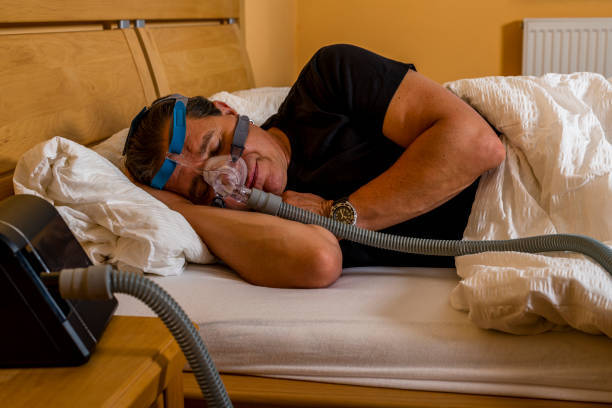Ophthalmologist explains how sleep apnea can contribute to eye damage: 'Many don't show symptoms until the damage is irreversible.'

Sleep apnea , a respiratory disorder characterized by repeated interruptions in breathing during the night, could play a significant role in the development of eye diseases such as glaucoma, according to ophthalmologist Fernando López, a specialist at the Miranza Gómez-Ulla Institute.
This condition causes an intermittent reduction in blood oxygen and changes in blood pressure , two factors that, combined, affect circulation in key ocular structures such as the optic nerve and retina.
López points out that these physiological changes can promote progressive eye damage, even in people with no prior ophthalmological history.
In particular, the specialist highlights a higher risk of suffering from normotensive glaucoma , a variant of glaucoma that develops without significant elevations in intraocular pressure, among patients who present snoring associated with apneas.
Furthermore, these individuals also face a higher likelihood of their eye disease progressing more rapidly , compared to those who do not suffer from sleep-disordered breathing. This form of glaucoma is particularly concerning because it is not always easily detected by conventional eye pressure monitoring.

Apnea causes intermittent hypoxia, a factor that can affect the visual field. Photo: iStock
Intermittent hypoxia , the cyclical decrease in oxygen in the body during sleep, is one of the main mechanisms by which apnea could affect visual health. Added to this are changes in intracranial pressure and reduced blood flow to the optic nerve, factors that together create an environment conducive to visual field deterioration.
These alterations can occur in both patients with a confirmed diagnosis of glaucoma and in people who have not yet been diagnosed , which increases the importance of preventive surveillance.

Sleep apnea is treated with this device. (Image). Photo: iStock
According to data from the Miranza ophthalmology network, glaucoma is one of the leading causes of irreversible blindness in Spain, with an estimated 500,000 people affected. Of these, more than 50% have not yet received a diagnosis, as the disease tends not to present obvious symptoms in its early stages. This fact underscores the need to increase awareness and early detection campaigns, especially among people with risk factors, such as sleep apnea.
Recognizing the connection between sleep apnea and eye damage has significant clinical implications. On the one hand, it suggests that patients with frequent sleep apnea and snoring should undergo regular ophthalmologic examinations to identify early signs of glaucoma . On the other hand, in individuals diagnosed with glaucoma, it may be advisable to investigate the presence of sleep-disordered breathing in order to address risk factors that can be modified if detected early.

Sleep apnea: the disorder that keeps you from sleeping well and can be serious. Photo: iStock
From this perspective, Dr. López emphasizes the need to integrate the ophthalmology specialty into the monitoring protocols for patients with sleep apnea. "It's not just about controlling sleep, but also protecting vision. Many of these patients don't present visual symptoms until the damage is irreversible," he says.
In this regard, it recommends the inclusion of preventive ophthalmological examinations as part of the clinical approach to sleep apnea , especially in people with a family history of glaucoma or ocular hypertension.
More news in EL TIEMPO *This content was rewritten with the assistance of artificial intelligence, based on information published by Europa Press, and reviewed by the journalist and an editor.
eltiempo



%3Aformat(jpg)%3Aquality(99)%3Awatermark(f.elconfidencial.com%2Ffile%2Fa73%2Ff85%2Fd17%2Fa73f85d17f0b2300eddff0d114d4ab10.png%2C0%2C275%2C1)%2Ff.elconfidencial.com%2Foriginal%2F58a%2F8f2%2F014%2F58a8f2014a5905919f95d72694d61f67.jpg&w=1280&q=100)
%3Aformat(png)%3Aquality(99)%3Awatermark(f.elconfidencial.com%2Ffile%2Fa73%2Ff85%2Fd17%2Fa73f85d17f0b2300eddff0d114d4ab10.png%2C0%2C275%2C1)%2Ff.elconfidencial.com%2Foriginal%2F972%2F505%2Fe12%2F972505e121dc61f9be872946a7b98578.png&w=1280&q=100)
%3Aformat(jpg)%3Aquality(99)%3Awatermark(f.elconfidencial.com%2Ffile%2Fa73%2Ff85%2Fd17%2Fa73f85d17f0b2300eddff0d114d4ab10.png%2C0%2C275%2C1)%2Ff.elconfidencial.com%2Foriginal%2F5e2%2Fa73%2F574%2F5e2a73574438ad7753bdc9ec02fabfc3.jpg&w=1280&q=100)